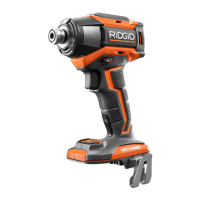
Do you have a question about the RIDGID OCTANE R86039 and is the answer not in the manual?
| Brand | RIDGID |
|---|---|
| Model | OCTANE R86039 |
| Category | Impact Driver |
| Language | English |
Ensures safe operation by maintaining a clean, well-lit workspace and avoiding hazardous atmospheres.
Guidelines for preventing electric shock, including proper plug use, grounding, and avoiding wet conditions.
Focuses on operator alertness, proper attire, protective equipment, and maintaining balance for safe tool handling.
Covers selecting the correct tool, proper operation, and maintenance to prevent damage and ensure safety.
Instructions for safe charging, handling, and storage of battery packs to prevent fire and injury.
Hold the tool by insulated surfaces to prevent shock from contact with hidden live wires.
Wear ear protectors to prevent hearing loss caused by impact driver noise.
Utilize auxiliary handles if supplied for better control and to prevent personal injury.
Read the manual carefully to understand applications, limitations, and potential hazards of the impact driver.
Always wear ANSI Z87.1 compliant eye protection with side shields to prevent eye injuries.
Wear a face or dust mask when operating in dusty conditions to protect your lungs.
Use hearing protection during extended use to prevent hearing damage.
Safe practices for battery-powered tools, including avoiding heat, fire, and damage to battery packs.
Avoid charging or storing batteries in extreme temperatures (below 50°F or above 100°F).
Handle battery leakage carefully, flushing skin with water and seeking medical attention if needed.
Keep instructions for future reference and to instruct others using the tool.
Defines DANGER, WARNING, CAUTION, and NOTICE signal words indicating hazard levels.
Explains symbols like Safety Alert, Read Manual, Eye Protection, Wet Conditions, and Recycle.
Details product specifications including speeds, coupler size, impacts per minute, and torque.
Highlights risks associated with improper assembly, missing parts, or product modification.
Covers operator carelessness, battery removal during adjustments, and safe use of attachments.
Lists the intended uses of the tool, such as driving screws, nuts, and bolts.
Explains automatic tool shutdown during overload and how to reset the tool.
Details the feature that deactivates the tool when overheated and how to resume operation.
Instructions for installing or uninstalling the belt hook on either side of the tool housing.
Describes how to control tool speed by varying trigger pressure.
Explains how to set the selector for forward, reverse, or center lock (off) operation.
Details the toggle button for adjusting speed and torque between low, medium, and high settings.
Explains how to cycle through and select modes like Self-Drilling, Fastener Assist, and Auto Stop.
Describes the mode for driving self-drilling screws, reducing stripping and breakage.
Details the mode for driving troublesome fasteners or removing stripped fasteners.
Explains the mode that automatically shuts down the tool to prevent over-tightening.
Step-by-step guide for securely installing and removing the battery pack from the tool.
Instructions for inserting and removing bits from the tool's coupler.
Information about the LED lights that illuminate the work area.
Guidance on proper technique for driving screws, nuts, and bolts with the impact driver.
Describes the function of the electric brake that stops bit rotation.
Provides contact details and guidance for obtaining parts, service, or locating authorized service centers.
